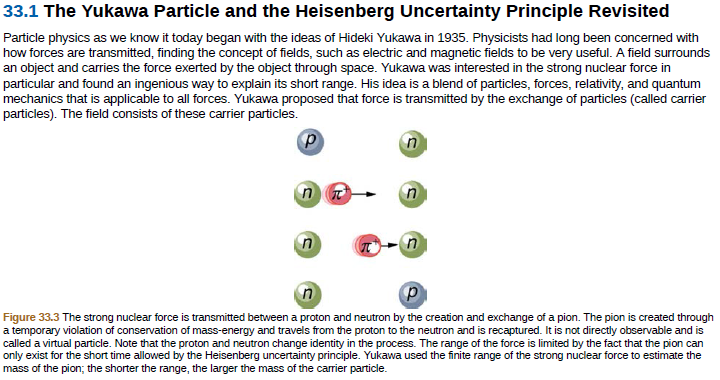33.1 The Yukawa Particle and the Heisenberg Uncertainty Principle Revisited Particle physics as we know it today began with the ideas of Hideki Yukawa in 1935. Physicists had long been concerned with how forces are transmitted, finding the concept of fields, such as electric and magnetic fields to be very useful. A field surrounds an object and carries the force exerted by the object through space. Yukawa was interested in the strong nuclear force in particular and found an ingenious way to explain its short range. His idea is a blend of particles, forces, relativity, and quantum mechanics that is applicable to all forces. Yukawa proposed that force is transmitted by the exchange of particles (called carrier particles). The field consists of these carrier particles. ,ה) ח Figure 33.3 The strong nuclear force is transmitted between a proton and neutron by the creation and exchange of a pion. The pion is created through a temporary violation of conservation of mass-energy and travels from the proton to the neutron and is recaptured. It is not directly observable and is called a virtual particle. Note that the proton and neutron change identity in the process. The range of the force is limited by the fact that the pion can only exist for the short time allowed by the Heisenberg uncertainty principle. Yukawa used the finite range of the strong nuclear force to estimate the mass of the pion; the shorter the range, the larger the mass of the carrier particle.
33.1 The Yukawa Particle and the Heisenberg Uncertainty Principle Revisited Particle physics as we know it today began with the ideas of Hideki Yukawa in 1935. Physicists had long been concerned with how forces are transmitted, finding the concept of fields, such as electric and magnetic fields to be very useful. A field surrounds an object and carries the force exerted by the object through space. Yukawa was interested in the strong nuclear force in particular and found an ingenious way to explain its short range. His idea is a blend of particles, forces, relativity, and quantum mechanics that is applicable to all forces. Yukawa proposed that force is transmitted by the exchange of particles (called carrier particles). The field consists of these carrier particles. ,ה) ח Figure 33.3 The strong nuclear force is transmitted between a proton and neutron by the creation and exchange of a pion. The pion is created through a temporary violation of conservation of mass-energy and travels from the proton to the neutron and is recaptured. It is not directly observable and is called a virtual particle. Note that the proton and neutron change identity in the process. The range of the force is limited by the fact that the pion can only exist for the short time allowed by the Heisenberg uncertainty principle. Yukawa used the finite range of the strong nuclear force to estimate the mass of the pion; the shorter the range, the larger the mass of the carrier particle.
Related questions
Question
The Yukawa Particle and the Heisenberg Uncertainty Principle Revisited
• Define Yukawa particle.
• State the Heisenberg uncertainty principle.
• Describe pion.
• Estimate the mass of a pion.
• Explain meson.

Transcribed Image Text:33.1 The Yukawa Particle and the Heisenberg Uncertainty Principle Revisited
Particle physics as we know it today began with the ideas of Hideki Yukawa in 1935. Physicists had long been concerned with
how forces are transmitted, finding the concept of fields, such as electric and magnetic fields to be very useful. A field surrounds
an object and carries the force exerted by the object through space. Yukawa was interested in the strong nuclear force in
particular and found an ingenious way to explain its short range. His idea is a blend of particles, forces, relativity, and quantum
mechanics that is applicable to all forces. Yukawa proposed that force is transmitted by the exchange of particles (called carrier
particles). The field consists of these carrier particles.
,ה) ח
Figure 33.3 The strong nuclear force is transmitted between a proton and neutron by the creation and exchange of a pion. The pion is created through
a temporary violation of conservation of mass-energy and travels from the proton to the neutron and is recaptured. It is not directly observable and is
called a virtual particle. Note that the proton and neutron change identity in the process. The range of the force is limited by the fact that the pion can
only exist for the short time allowed by the Heisenberg uncertainty principle. Yukawa used the finite range of the strong nuclear force to estimate the
mass of the pion; the shorter the range, the larger the mass of the carrier particle.
Expert Solution
This question has been solved!
Explore an expertly crafted, step-by-step solution for a thorough understanding of key concepts.
This is a popular solution!
Trending now
This is a popular solution!
Step by step
Solved in 3 steps with 1 images
